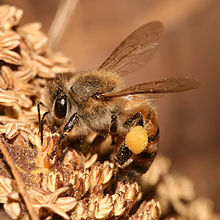西方蜜蜂
| 西方蜜蜂 | |
|---|---|

| |
| 科学分类 | |
| 界: | 动物界 Animalia |
| 门: | 节肢动物门 Arthropoda |
| 纲: | 昆虫纲 Insecta |
| 目: | 膜翅目 Hymenoptera |
| 科: | 蜜蜂科 Apidae |
| 属: | 蜜蜂属 Apis |
| 种: | 西方蜜蜂 A. mellifera
|
| 二名法 | |
| Apis mellifera Linnaeus, 1758
| |
| 亚种 | |
| |

| |
| 异名 | |
| |
西方蜜蜂或欧洲蜜蜂[1](学名:Apis mellifera)是一种蜜蜂。其 Apis 是拉丁文的蜜蜂,种小名 mellifera 为“带有蜜糖”。卡尔·林奈(Carolus Linnaeus)后来发现蜜糖其实是蜜蜂制造的,故想更正其种小名为mellifica,即“制造蜜糖”的意思。不过根据《国际动物命名法规》,首先命名的学名才是有效的。西方蜜蜂的基因组于2006年被完全排序及分析。
特征
[编辑]


西方蜜蜂是蜜蜂属下的一个蜜蜂品种,原始分布于亚洲西部、非洲、欧洲,包括许多不同的亚种,因欧洲人殖民欧亚非各地,将原产于欧洲的西方蜜蜂欧洲亚种带到世界各地,目前人工养殖的蜜蜂大部分都是西方蜜蜂,少量为另一品种东方蜜蜂。
在美国,欧洲蜜蜂代表的几个杂交繁殖欧洲亚种,包括意大利蜂( Apis mellifera ligustica Spinola)、卡尼鄂拉蜂(Apis mellifera carnica Pollmann)、欧洲黑蜂(Apis mellifera mellifera Linnaeus)、高加索蜂(Apis mellifera causcasia Pollmann),以及伊比利亚蜂(Apis mellifera iberiensis Engel)。这些亚种的引入最早可以追溯到1622年。50年代后期,一个亚种的非洲蜜蜂,东非蜂(Apis mellifera scutellata Lepeletier)被引入美洲,且可与欧洲亚种杂交。[2]
欧洲亚种
[编辑]- 意大利蜂(A. m. ligustica)是北美洲、南美洲及南欧最普遍养殖的西方蜜蜂。它们非常温和,容易维持大群,并且可以生产大量的蜂蜜。它们在冬天时仍维持大群,故需较多的食物,导致不适合在严寒气候养殖。它们一般呈皮革色,一些群族会呈金色。有时用意大利蜂指代所有亚种的Apis mellifera,
- 卡尼鄂拉蜂(A. m. carnica)分布在斯诺文尼亚的卡尼奥拉、奥地利阿尔卑斯山南部及巴尔干半岛北部。它们极度温和,在养蜂界中十分闻名。它们呈现深色,会缩减群势过冬,并在春天快速扩建恢复蜂群的群势。它们是山区蜜蜂,适合栖息在较寒冷气候的地区。
- 高加索蜂(A. m. caucasica)分布在高加索山脉。它们非常温和及较为勤劳。是生产蜂胶最好的品种。它们的体型在中等算较大,有时呈灰色。
- 黄色高蜂(A. m. remipes)分布在高加索山脉、伊朗及里海。
- 欧洲黑蜂(A. m. mellifera)分布在北欧。于现代被驯养,并于殖民地时期被带到北美洲。它们细小及呈深色。在北美洲及西欧有欧洲黑蜂及意大利蜂的混种,会无故刺人。纯种的欧洲黑蜂已接近灭绝,但并不带有攻击性。
- 伊比利亚蜂(A. m. iberiensis)分布在伊比利亚半岛。
- 塞克比亚蜂(A. m. cecropia)分布在希腊南部。
- 塞浦路斯蜂(A. m. cypria)分布在塞浦路斯,被地中海所孤立。它们较意大利蜂粗暴。
- A. m. ruttneri是马耳他的亚种。
- 西西里蜂(A. m. sicula)分布在意大利的特拉帕尼及西西里岛的乌斯蒂卡岛。
非洲亚种
[编辑]一些学者及养蜂家认为非洲的西方蜜蜂亚种会在食物短缺时匿藏在蜂巢中,而不像欧洲的亚种般在蜂巢中死去。
- 东非蜂(A. m. scutellata)分布在中非及西非,在南美洲、中美洲及美国南部有混种。沃里克·埃斯特万·克尔(Warwick Kerr)曾于1956年从坦桑尼亚将一些东非蜂的蜂后带回巴西的圣保罗,但在过程中一些蜂后走失了,并与当地的蜜蜂混种产生了杀人蜂。[3]东非蜂会花较多精力在保护蜂巢,有时也会放弃现有蜂巢,转往更为安全的地方。东非蜂呈皮革色,很难用肉眼分辨它们与意大利蜂。
- 海角蜜蜂(A. m. capensis)分布在南非,工蜂有时能产下受精卵。
- 乞力马扎罗蜂(A. m. monticola)分布在东非的艾利根山、乞力马扎罗山、肯尼亚山及梅卢山海拔1500-3100米的地区。
- 撒哈拉蜜蜂(A. m. sahariensis)分布在非洲西北部摩洛哥的沙漠。它们只面对少数非人类的掠食者的威胁,故非常温和。由于它们身处绿洲中的植物缺乏花蜜,它们可以往远达5里以外的地方觅食。
- 突尼斯蜂(A. m. intermissa)分布在非洲北部的摩洛哥、利比亚及突尼斯。它们呈黑色。它们极度凶猛,在没有警告下都会攻击。它们很勤力。
- A. m. major分布在摩洛哥西北部的里夫山。它们可能是突尼斯蜂的褐色变种,与突尼斯蜂有解剖上的分别。
- 塞内加尔蜜蜂(A. m. adansonii)源自于尼日利亚及布基纳法索。
- 单色蜜蜂(A. m. unicolor)分布在马达加斯加。
- 埃及蜜蜂(A. m. lamarckii)分布在埃及的尼罗河河谷及苏丹。在美国加利福尼亚州也可以发现这类线粒体类型。[4]
- 坦桑海滨蜂(A. m. litorea)分布在东非的低海拔地区。
- 苏丹小蜂(A. m. nubica)分布在苏丹。
- 也门蜜蜂(A. m. jemenitica)分布在索马里、乌干达、苏丹及也门。
中东及亚洲亚种
[编辑]- 马其顿蜂(A. m. macedonica)分布在马其顿及希腊北部。
- 波斯蜜蜂(A. m. meda)分布在伊拉克。
- A. m. adamii分布在克里特。
- 亚美尼亚蜂(A. m. armeniaca)分布在中东、高加索及亚美尼亚。
- 安纳托利亚蜂(A. m. anatoliaca)分布在土耳其安那托利亚的中央区域及伊拉克,最东至亚美尼亚。
- 叙利亚蜂(A. m. syriaca)分布在叙利亚近东及以色列。
- 卡赫斯坦蜂(A. m. pomonella)是天山山脉的特有种,是西方蜜蜂分布最东的亚种。
基因组
[编辑]西方蜜蜂是继果蝇及蚊之后第三种有基因图谱的昆虫。根据分析,它们是源自非洲,并于史前两次的迁徙分布至欧洲。[5]它们与嗅觉有关的基因较味觉的为多,相比果蝇及蚊,它们免疫的基因却较少。[6]它们生理节律的基因组与脊椎动物相似,多于昆虫。另外,控制酶的基因也较接近脊椎动物。[7]
威胁
[编辑]西方蜜蜂的生存面对着不同的威胁。在北美洲及欧洲养殖的蜂群于1990年代初备受瓦螨的侵扰,而在美国亦于2006年及2007年出现蜂群崩坏症候群。[8]化学方法可以帮助解决瓦螨的问题,但瓦螨也渐渐产生抗药性。新品种已经可以减少依赖杀螨剂。瓦螨的问题只存在人工养殖的西方蜜蜂亚种, 许多野生的西方蜜蜂亚种都有抗瓦螨的能力。杀虫剂的使用亦影响了西方蜜蜂。
环境威胁
[编辑]在北美洲,杀人蜂广泛分布在美国南部,造成对人类的危害。野生蜜蜂作为入侵物种,在非原住的地方造成环境问题。进口的蜜蜂会竞争及取代原生的蜂类及鸟类,并帮助入侵植物的生长。不像原住的蜜蜂,它们不会正式地从雄蕊的花药抽取或传播花粉,而是振动授粉。例如,蜜蜂令多花野牡丹的果实产出减少。[9]
掠食者
[编辑]西方蜜蜂的掠食者包括有昆虫(如食虫虻、螳螂、蜻蜓及欧洲狼蜂等)、蜘蛛(如梢蛛属、绿猞猁蜘蛛、金蛛属及捕鱼蛛)、爬行类及两栖类(如美国牛蛙)、鸟类(蜂虎科及霸鹟)及哺乳动物(如南美小麝鼩属、臭鼬科、浣熊、蜜獾、熊及人类)。
参考
[编辑]- ^ Ashley N. Mortensen, Daniel R. Schmehl, Jamie Ellis, Entomology and Nematology Department, University of Florida. European honey bee - Apis mellifera. 佛罗里达大学. August 2013 [2015-08-08]. (原始内容存档于2021-04-28) (英语).
The western honey bee, Apis mellifera Linnaeus, naturally occurs in Europe, the Middle East, and Africa. This species has been subdivided into at least 20 recognized subspecies (or races), none of which are native to the Americas. However, subspecies of the western honey bee have been spread extensively beyond their natural range due to economic benefits related to pollination and honey production.
- ^ Ashley N. Mortensen, Daniel R. Schmehl, Jamie Ellis, Entomology and Nematology Department, University of Florida. European honey bee - Apis mellifera. 佛罗里达大学. August 2013 [2015-08-08]. (原始内容存档于2021-04-28) (英语).
In the United States, “European” honey bees (Fig. 1) represent a complex of several interbreeding European subspecies including; Apis mellifera ligustica Spinola, Apis mellifera carnica Pollmann, Apis mellifera mellifera Linnaeus, Apis mellifera causcasia Pollmann, and Apis mellifera iberiensis Engel. Introduction of these subspecies dates back to early American settlers in 1622. More recently (late 1950s), a subspecies of African honey bee, Apis mellifera scutellata Lepeletier, that can interbreed with European subspecies was introduced into the Americas.
- ^ Abramsona, Charles I. ; Aquinob, Italo S. Behavioral Studies of Learning in the Africanized Honey Bee (Apis mellifera L.) (PDF). Brain, Behavior, Evolution. 2002, 59: 68–86 [2009-07-06]. (原始内容存档 (PDF)于2012-10-10).
- ^ D. I. Nielsen, P. R. Ebert, R. E. Pagee, G. J. Hunt, and E. Guzmán-Novoa. Improved Polymerase Chain Reaction-Based Mitochondrial Genotype Assay for Identification of the Africanized Honey Bee (Hymenoptera: Apidae). Annals of the Entomological Society of America. 2000, 93 (1): 1–6. doi:10.1603/0013-8746(2000)093[0001:IPCRBM]2.0.CO;2.
- ^ Whitfield, CW; Behura SK, Berlocher SH, Clark AG, Johnston JS, Sheppard WS, Smith DR, Suarez AV, Weaver D, Tsutsui ND. Thrice out of Africa: ancient and recent expansions of the honey bee, Apis mellifera. Science. Oct 27, 2006, 314 (5799): 642–645. PMID 17068261. doi:10.1126/science.1132772.
- ^ Honeybee Genome Sequencing Consortium. Insights into social insects from the genome of the honeybee Apis mellifera. Nature. Oct 26, 2006, 443 (7114): 931–949. PMID 17073008. doi:10.1038/nature05260.
- ^ Wang, Y; Jorda M, Jones PL, Maleszka R, Ling X, Robertson HM, Mizzen CA, Peinado MA, Robinson GE. Functional CpG methylation system in a social insect. Science. Oct 27, 2006, 314 (5799): 645–647. PMID 17068262. doi:10.1126/science.1135213.
- ^ Mystery Bee Disappearances Sweeping U.S.. National Geographic News. [2007-03-10]. (原始内容存档于2017-07-30).
- ^ Gross, C. L., Mackay, D. Honeybees reduce fitness in the pioneer shrub Melastoma affine (Melastomataceae). Biological Conservation. 1998, 86: 21.
外部链接
[编辑]- 蜜蜂概述
- BeediseasesArchive.is的存档,存档日期2013-06-16 Honey bee diseases website by Dr. Guido Cordoni.
- Cornwall Honey Beepedia (页面存档备份,存于互联网档案馆)
- 西方蜜蜂的相片 (页面存档备份,存于互联网档案馆)
- BeeSource (页面存档备份,存于互联网档案馆)
